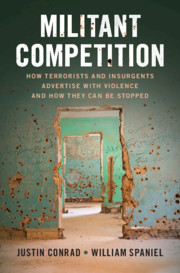 Militant Competition
Militant Competition Published online by Cambridge University Press: 17 September 2021
Target governments can reduce grievances among disaffected populations who might otherwise pledge support to a group. Incorporating this into the workhorse model, we show an unexpected relationship between the total number of groups and total violence observed. When few groups exist, the target state has little incentive to reduce grievances. Due to the lack of competition, the government calculates that paying that price in violence is worth offering fewer concessions. In contrast, when many groups exist, the competition instills great fear in the target state. As a result, it may calculate that entirely abandoning the objectionable policy is the best solution. Without any supporters to recruit, the groups then drop their violence outputs. Thus, violence may decrease in the number of competing groups because violence deters the government. We characterize the circumstances under which the deterrent effect dominates the competition effect and provide broader tips for the empirical literature on outbidding.
To save this book to your Kindle, first ensure [email protected] is added to your Approved Personal Document E-mail List under your Personal Document Settings on the Manage Your Content and Devices page of your Amazon account. Then enter the ‘name’ part of your Kindle email address below. Find out more about saving to your Kindle.
Note you can select to save to either the @free.kindle.com or @kindle.com variations. ‘@free.kindle.com’ emails are free but can only be saved to your device when it is connected to wi-fi. ‘@kindle.com’ emails can be delivered even when you are not connected to wi-fi, but note that service fees apply.
Find out more about the Kindle Personal Document Service.
To save content items to your account, please confirm that you agree to abide by our usage policies. If this is the first time you use this feature, you will be asked to authorise Cambridge Core to connect with your account. Find out more about saving content to Dropbox.
To save content items to your account, please confirm that you agree to abide by our usage policies. If this is the first time you use this feature, you will be asked to authorise Cambridge Core to connect with your account. Find out more about saving content to Google Drive.